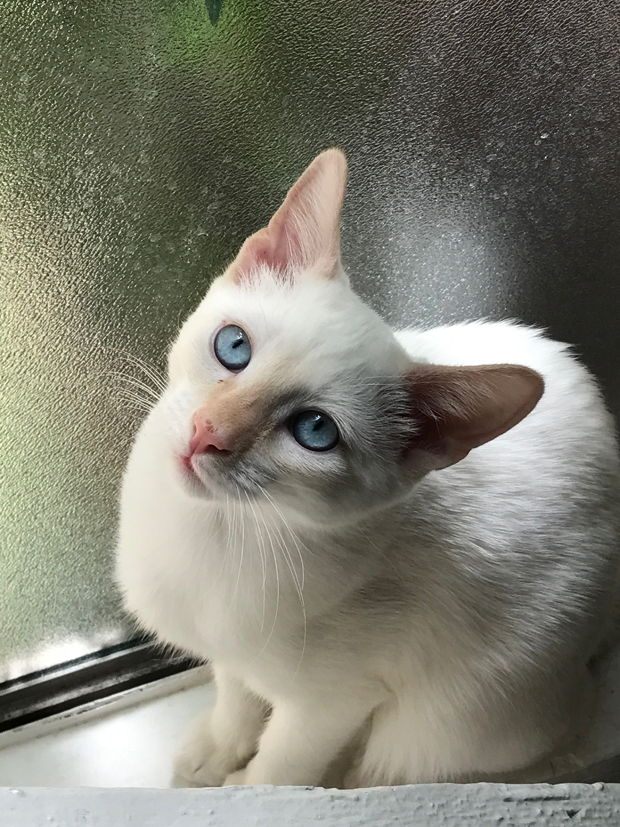
All photos by Meredith Kennedy. Loki, one of two orphaned Siamese mixes.
Wichienmaat means “Siamese Cat” in Thailand, which was originally called Siam, where this beautiful and popular cat derives its name. This very old breed was popular with boat people in Thailand, and the characteristics that made it a successful “boat cat” are still apparent today: gregariousness, sociability, extroversion and attention seeking. Because of these traits, Siamese cats thrive best with one or more companion cats in the same household.
An interesting genetic variation of the original Siamese cat left them without a tapetum lucidum, the reflective coating inside the back of the eye. The tapetum lucidum is a reflective surface that amplifies low levels of light and gives cats their superior night vision. Without this adaptation, it is possible that ancestral Siamese cats were more dependent on their human companions than other cats were.
Siamese cats may have been more successful catching mice and rats aboard the confines of small boats of the boat people as opposed to the larger areas in which cats hunt on land. This would have been a benefit to the people living on the boats, and the natural selection of cats suited for living in small quarters with human activity may have shaped the gregarious personality of the modern-day Siamese cat.
The missing tapetum lucidum is related to the albino allele of Siamese genetics. The distinctive “point color” pattern of Siamese cats is a form of partial albinism resulting from a mutation in tyrosinase, an enzyme essential to melanin production. Melanin creates color, but this mutated melanin enzyme is heat sensitive and doesn’t work at normal body temperatures. However, it is effective at the cooler temperatures that are found in body parts farthest away from the core: feet, tail, ears and face.
Siamese kittens all start out as pure white, and their colors develop as they grow, starting at the feet, tail tips, ear tips and nose. By one month of age, their point color is usually apparent, seal point and blue point being the two original colors. Seal points are dark seal brown, lightening to a warm cream body color. Blue points are dark slate gray, lightening to a pale, light-grayish body. The color dilutions of these two are chocolate point, which is a lighter version of seal, and lilac point, a lighter version of blue, so the foundation four colors of the Siamese are seal, chocolate, blue and lilac points. All Siamese, whether purebred or crossbred, have blue eyes.
A physical characteristic of the original Siamese cat was a kink in the end of the tail. As legend has it, the kink served as a place for a Thai princess to keep her rings on while she bathed. This, along with the original crossed eyes, has largely been bred out of today’s Siamese cats.
Loki and Chai, two of our tribe of foster kittens, have Siamese coloring, meaning that they have a great deal of Siamese in their genetic makeup. Their parents are unknown, of course, since they were orphaned foundlings, but both the mother and father of these kittens, each from a different litter, would have had to carry Siamese genes. They both started out as pure-white, blue-eyed babies, developing their pointed colors as they grew.
Chai’s feet, face, ears and tail turned dark brown very early on, identifying him as a seal point. A chocolate point would have started as a much lighter, warm chocolate brown. Chai’s color will continue to develop until his legs, entire tail, face and ears are a solid, dark seal brown, with a creamy beige body. Loki, on the other hand, continued to look like a blue-eyed, white kitten until six weeks of age, when the tips of his feet, ears, nose and tail started turning a pale apricot orange.

Chai, with seal points, and Loki, with flame points.
Other colors and patterns have been bred into Siamese genetics, resulting in red-point, or flame-point; lynx-point; and tortie-point variations. Cats with these newer colors are classified as a separate breed, the colorpoint shorthair, but they originated from the Siamese.
Loki is still young, so it’s not yet apparent whether he will be a red point or the color dilution of cream point, a lighter version of red. Technically, these two mixed-breed kittens would be called a seal-point Siamese mix (Chai) and a flame-point colorpoint shorthair mix (Loki). Both kittens have the classic Siamese blue eyes, with no kinks in their tails, and Chai has inherited the tendency to be “talkative,” vocalizing in a raspy Siamese voice.
Chai, showing his true colors.
The kittens’ gregarious nature is apparent. They provide companionship for each other and get a lot of exercise through play fighting and chasing each other around. These natural cat behaviors are important for the mental and physical well-being of indoor cats, no matter what the breed or mix!

